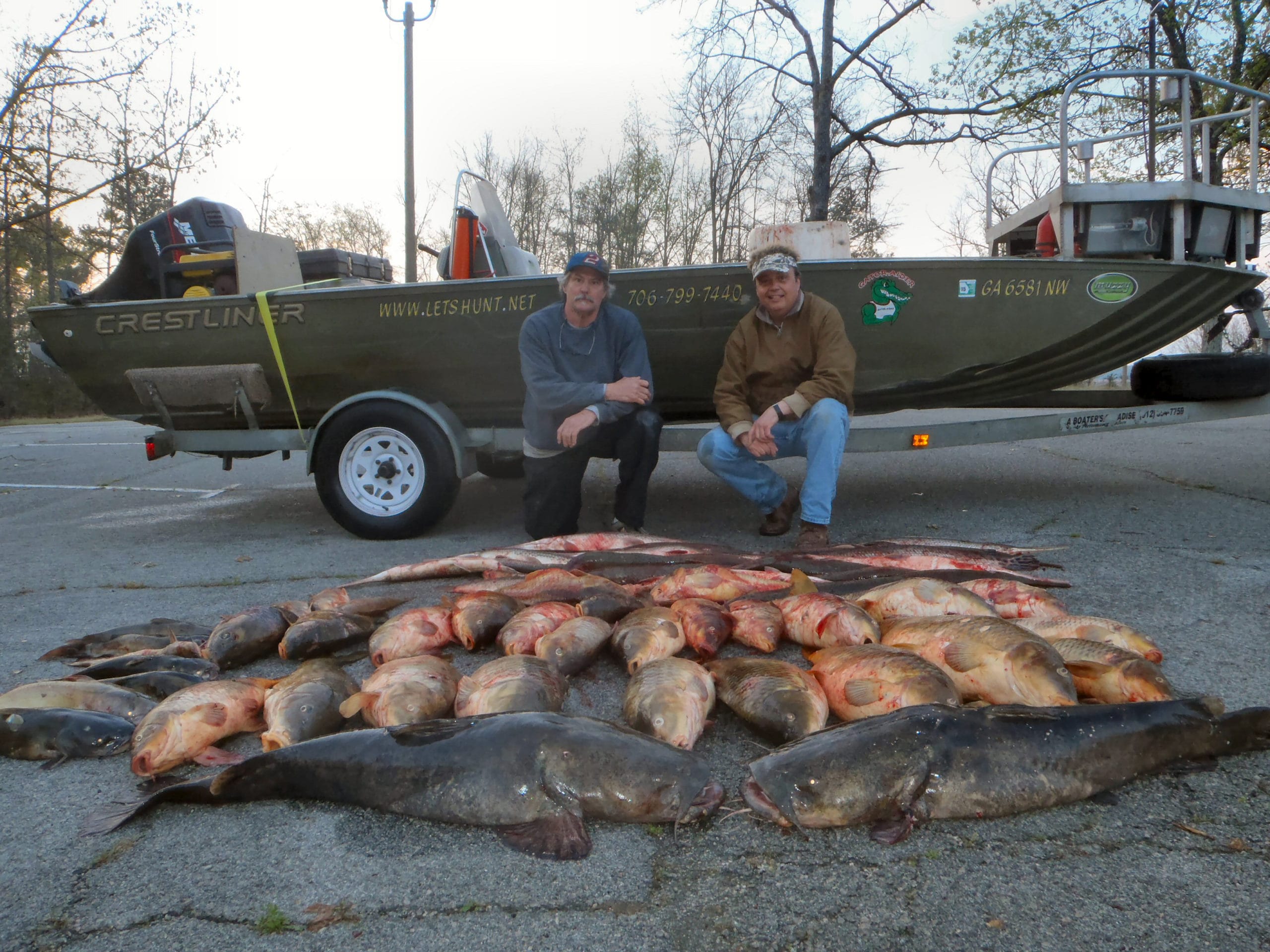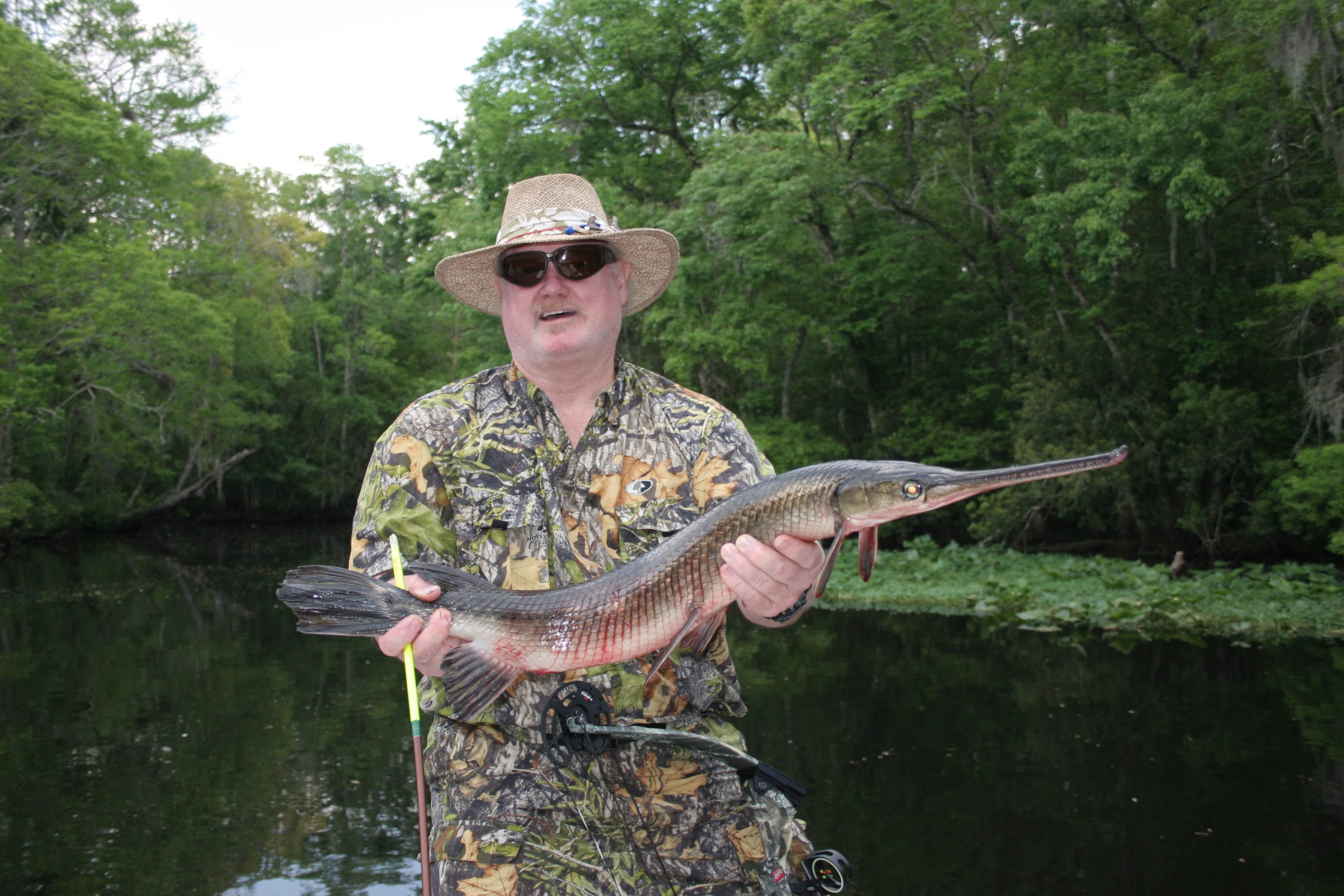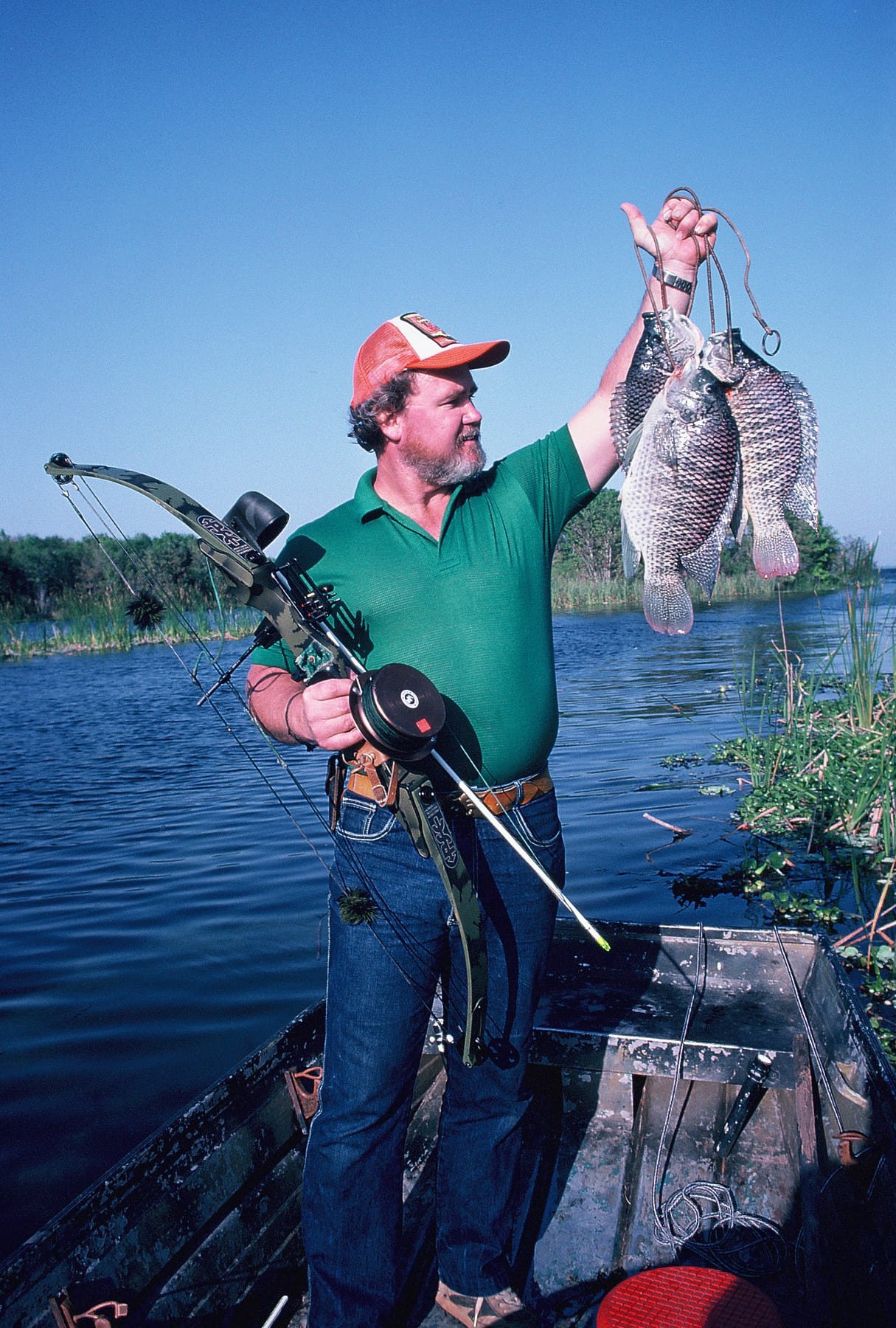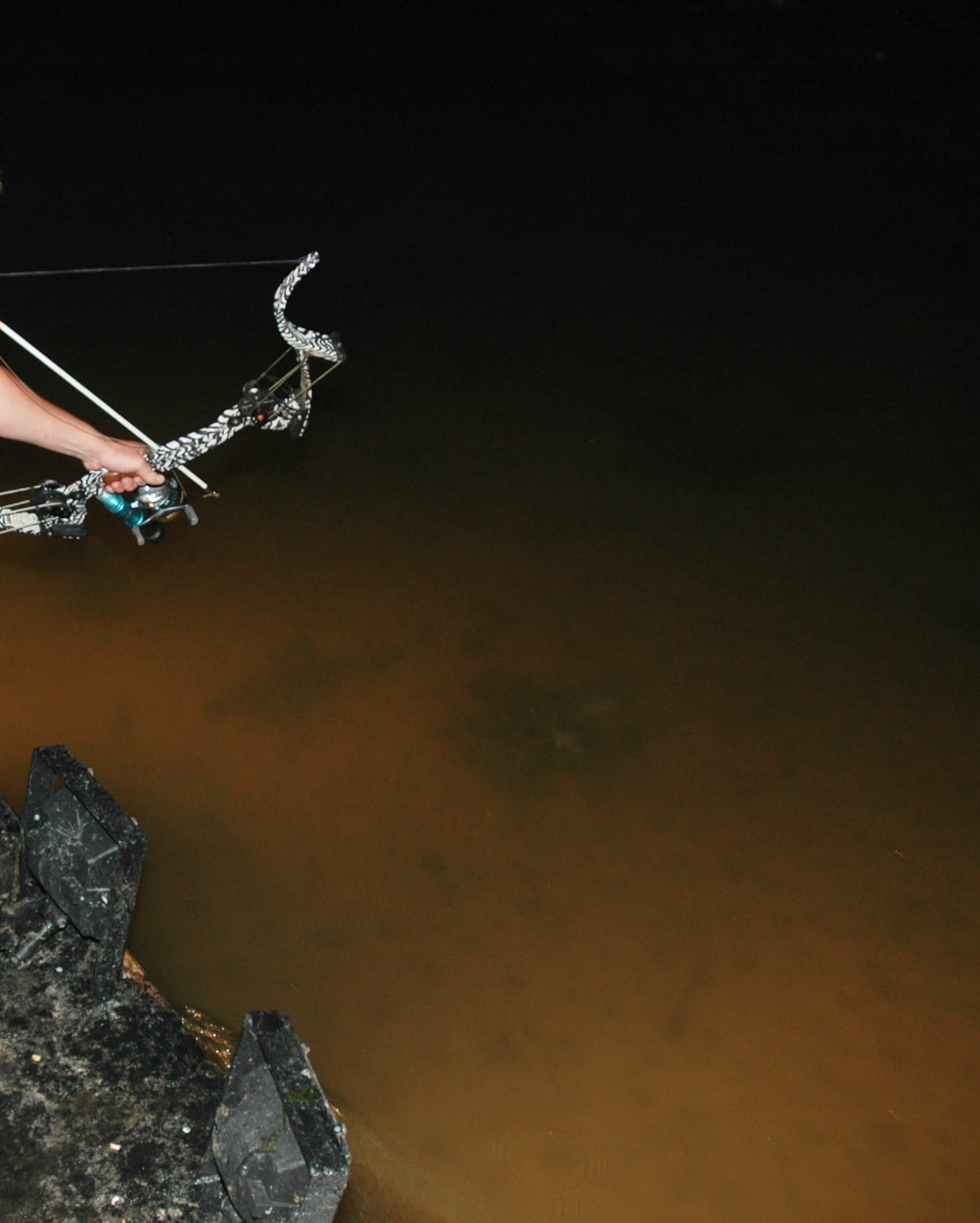by Bob McNally
Bowfishing is an exciting, easy-to-do sport that’s fun, and it also practical—keeping a bowhunter active with his equipment during spring and summer.

Michael Evans (right) is a tournament bowfisherman who also guides clients, specializing in night fishing trips that produce endless shot opportunities.
And this isn’t “shooting fish in a barrel” either. Hitting a moving fish 3 feet deep with an arrow takes plenty of skill.
Laws vary from state to state, but bowfishing is legal almost everywhere. However, be sure to check local regulations to learn what species of fish are lawful for bow harvest, and what seasons of the year they may be taken. Most states require bowfishermen to have a fishing license, for example.
“Rough fish” such as gar, carp, buffalo, catfish, suckers and tilapia are typical freshwater bowfishing targets. A multitude of marine fish may be shot with bows, too, including such abundant targets as stingrays, which are excellent table fare.
In spring, most freshwater “rough” fish species can be found without much difficulty in shoreline spawning areas, especially below dams, in creeks and quiet back-bays off lakes.

All gar are classed as rough fish. They are among the most popular targets of bowfishermen, especially in the summer when gar are found daylight and dark cruising or loafing in shallow water.
Carp are the traditional target of bowfishermen everywhere. The bottom feeders are big (10- to 20-pounders common), and in most areas they’re considered undesirable because they displace game species like bass and trout. In addition, carp can be found in huge numbers in lakes and rivers that offer poor or marginal sportfishing.
A pond or river where bass fishing is poor can offer great carp bowfishing. Thus, bowfishing for carp can be superb in large urban areas— lakes, ponds and rivers where few sportsmen consider casting a lure. And bowmen who shoot carp are doing sport anglers a favor by removing the species from waters where fisheries departments are trying to increase bass and other gamefish populations.
Carp spawn in spring, usually in large, muddy bays during bright warm days. In a lake loaded with carp, a quick boat tour of shoreline shallows should reveal prime areas where carp are spawning. Normally the water is muddy from carp grubbing on shallow bottom. Also, carp frequently are seen rolling at the surface or pushing wakes in shallows.
Big carp weighing over 10 pounds can be spooky, so archers who wade or quietly walk shorelines at times can be more successful than bowmen in boats. Working the shallowest waters also is necessary because actively spawning carp can jam in water so skinny their backs break the surface.
Tailraces below dams are great places for spring bowfishing because rough fish mass there in their up-stream migrations for spawning. Often the very best bowfishing in tailraces occurs weeks before the action peaks in lakes since river fish begin their migrations upstream before they actively begin spawning.

Bowfishing for tilapia is popular for many Floridians. These non-native, exotic fish are great table fare.
In Florida one of the most popular bowfishing targets is the non-native blue tilapia, often erroneously called Nile Perch. This 2- to 4-pound fish is bream shaped and makes spring nests in bass spawning areas that look like bomb craters. Tilapia are classed as an “exotic” by the state fisheries department because the fish were accidentally introduced into the state. Blue tilapia eat weeds and insects, so they’re rarely caught by anglers. Further, they are believed to displace spawning bass, so the state and most anglers want them out.
In many lakes throughout America, gar are top targets for archers. In some areas bowfishing tournaments with big dollar purses are held for gar and other species. While spring bowfishing for gar can be good, summer action is best.
Enthusiastic archers build and use special boats designed specifically for bowfishing. They have large, high decks— both fore and aft— and some have powerful lights used for night bowfishing.
Night bowfishing has become so popular in some areas that full-time guides such as Michael Evans, of Sparta, Ga., (www.letshunt.net) specialize in night bowfishing. He provides all equipment for $75 per hour for up to three persons. Some nights from his specially outfitted boat his archers get more than 1,000 shots with their bows, collecting barrels full of suckers, carp and other rough fish. The largest carp taken off his boat is an 82-pounder, and they’ve shot buffalo to 68 pounds.
Gar are great bow targets because in summer they frequently “sun” or cruise near the surface, making them vulnerable to archers. Naturally, the nearer the surface the fish the easier it is to hit with an arrow.
Finally, rough fish taken with a bow and arrow are good to eat, so don’t waste it. Catfish and tilapia delicious, and even gar, buffalo and carp are table fare when cleaned and iced promptly after shooting. Deep frying, pan frying, broiling or smoking can make even rough fish taste like a gourmet delicacy.
Aim Low At Underwater Targets

Aiming lower than a fish appears is necessary when bowfishing.
Refraction is the bane of bowfishermen. This is the way water “bends” light waves, and it makes a fish appear where it is not. And the deeper a fish holds in the water column, the more refraction comes into play.
What this means is that an archer must aim well below where he sees a fish in order to hit it with his arrow. In the case of a fish down four or five feet, an arrow must be aimed two feet or more below the fish to strike it.
Refraction of light waves makes a fish appear higher in the water column than it actually is. And that makes successful bowfishing all the more difficult, and rewarding when archers succeed.
Salty Side Of Bowfishing
There are tremendous opportunities for saltwater bowfishing throughout America’s coastal regions. Sharks and stingrays are standard targets for bowmen, but flounder and mullet also offer excellent sport.
Instead of gigging flounder at night on shallow flats in spring and summer, bowfishermen can use archery gear.
In many coastal tidewater areas during summer, mullet can be found in huge schools cruising just below the surface, and frequently far up tidal rivers long miles from the coast.
Sharks may be the ultimate bowfishing targets because they’re big, extremely tough, and abundant during summer. Almost all coastal areas have sharks, which can be chummed close to archers for exciting action sure to stir a shooter’s nerves.
The Union Sportsmen’s Alliance website is designed to provide valuable articles about hunting, fishing and conservation for members of AFL-CIO affiliated labor unions and all sportsmen and sportswomen who appreciate hunting and fishing and want to preserve our outdoor heritage for future generations. If you would like your own story and experience from the outdoors to be considered for our website, please email us at USAmembers@unionsportsmen.org.



